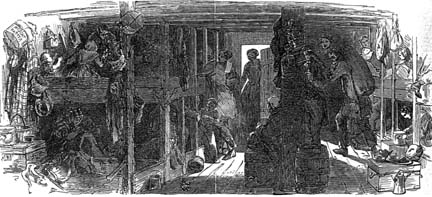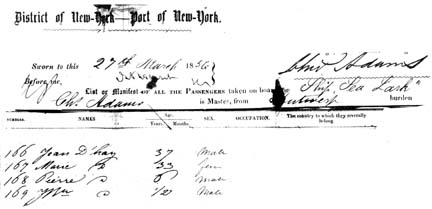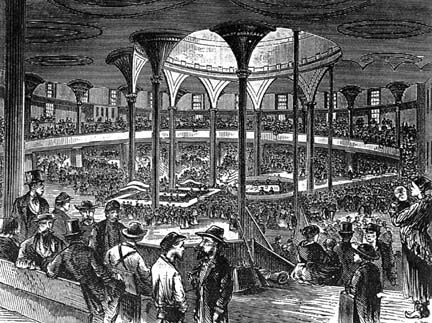Jean Joseph Dhuy's voyage to
America
 Jean Joseph Dhuy and his family traveled to America
"between decks", or in steerage, as seen in this
Jean Joseph Dhuy and his family traveled to America
"between decks", or in steerage, as seen in this
1851 picture. Sailing ships in those years crossed to Europe heavily
laden with American cargoes of
tobacco, cotton, rice, or timber. For the west-bound journey,
temporary flooring and bunks were installed (basically, wooden
platforms covered with straw) and immigrants were crammed to capacity
- as
profitable ballast. Belgian emigration laws at that time required
that all departing passengers be cleared
for health purposes by a doctor before a journey, yet the experience
of reaching New York was still
exhausting, frightening,and often dangerous. There were 227
passengers aboard the Sea Lark - 171
Belgians, 27 Prussians, and 29 other Germans. All but 22 were in
steerage. Eleven passengers (five
percent) died during the voyage; all were under the age of five.
 The American ship Sea Lark brought Jean Joseph Dhuy
and family from Antwerp,Belgium to
The American ship Sea Lark brought Jean Joseph Dhuy
and family from Antwerp,Belgium to
New York City in 1856. His son Jean Baptiste ("J.Bte") died during
the voyage; his older son
Philippe is mistakenly referred to as "Pierre" on this copy of the
manifest. Their date of departure from
the port of Antwerp is believed to be on or about February 6, 1856.
Jean Joseph and Marie Franoise
(Bouffioux) Dhuy were actually one of four families from Ernage,
Belgium to come to America at
the same time aboard the Sea Lark. The other three: Jean
Baptiste and Marie Josephe (Bouffioux)
Quinart; Dieudonne and Julienne (Annoye) Cochart; and Jean Joseph and
Marie Therese (Ancisse)
Debauche; and their various children. The Cocharts and the Debauches
settled near the Dhuys in
Lincoln township, Kewaunee County.
 A bird's-eye view of the port of New York as it appeared
to the Dhueys upon their arrival in 1856.
A bird's-eye view of the port of New York as it appeared
to the Dhueys upon their arrival in 1856.
Castle Garden, the round building extending from Battery Park at the
foot of Manhattan Island,
was opened the previous year as America's first receiving station for
immigrants. From 1855 to
1890 some eight million newcomers would pass through it.
 The interior of the Castle Garden, in an 1871 engraving.
The floor of the rotunda, a former theater,
The interior of the Castle Garden, in an 1871 engraving.
The floor of the rotunda, a former theater,
was divided into separate areas for English-speaking immigrants and
others, and was estimated
to hold anywhere from 2,000 to 4,000 people. Officials did their best
to register immigrants
quickly, help them exchange money, buy railroad tickets, transport
baggage, and find a job
or a place to stay.
From New York the Dhuys would have proceeded by train
towards Wisconsin. A common route of
this time would be to pass through Albany and Buffalo, cross Lake
Erie to Detroit, then again by train
to Lake Michigan (at St. Joseph), and finally by boat to the Belgian
settlements of northeast Wisconsin.
In 1850 there were only 45 Belgian natives in the state; by 1860
there were 4,647.
Jean Joseph Dhuy in
America




